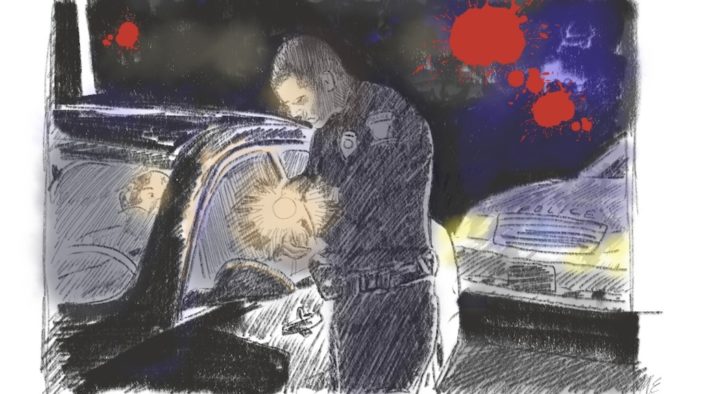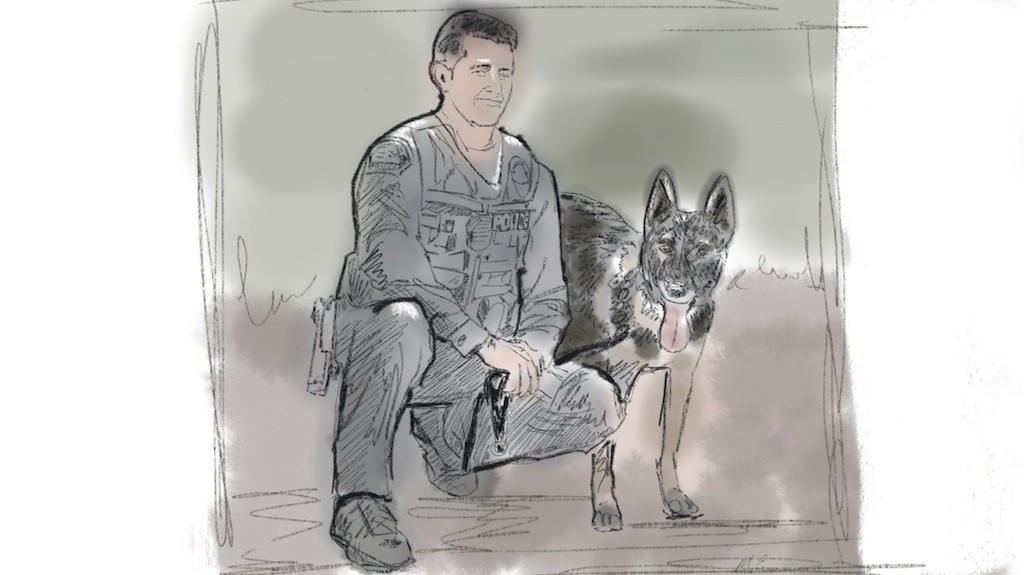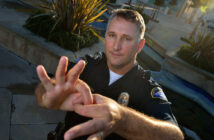Editor’s note: On Friday, March 16, 2018, a parolee gang member was sentenced to 60 years to life in state prison for attempting to murder a Fullerton Police Department officer. The incident was detailed in the below article, which originally was published on Aug. 10, 2016. The officer requested that his name and photo not be included in the story. His would-be killer, Marcos Allen Bush, 34, of Santa Ana, was convicted of the point-blank shooting by an Orange County jury on March 15, 2017, according to an Orange County District Attorney’s Office news release Monday, March 19, 2018. Senior Deputy District Attorney Gary Logalbo of the Gang/TARGET Unit prosecuted the case.
When the officer cradles one of his three young children in his arms, his heart burns with love.
When their heads rest on his right arm, the tiny bullet fragments still inside his arm stab into muscle.
Burning pain.
“It hurts like crazy,” the officer says, “but I still hold them.”
The officer’s kids are 5, 1 ½ and 6 months.
The 5-year-old was 18 months old when her father took six bullets during a routine traffic stop — among the sadly growing number of police officers who, in recent years, have been attacked by gunmen.
Last month was one of the bloodiest.
In July, 35 police officers were shot in the U.S. — 13 fatally, making it the bloodiest month in terms of gun violence against police in the most violent year for police in at least a decade, according to a Behind the Badge OC analysis of media reports. Already this year, 176 police officers have been shot — 36 killed by gunfire.
This O.C. officer was hit with six rounds from a Glock .45 pistol during a car stop on March 17, 2013.
Four of the bullets tore through his flesh: two went through his right arm, one went through his left leg and one went through his right hip.
“A lot of stuff was going through my head while I was getting shot,” the officer said.
One thought: his daughter.
“Literally while I’m getting shot, I remembered — and I don’t know how I thought about it, how I had time to think about it — but I thought, ‘Being 18 months old, is she going to remember me if I die?’”
***
When the officer got shot, he was 32 and an eight-year veteran of a municipal agency.
He was a K9 officer working the 5:30 p.m. to 3:30 a.m. patrol shift.
After clearing a call, the officer pulled onto a major road behind a dark-colored Pontiac Grand Prix with dark-tinted windows.
He ran the license plate.
The car came back with a warrant attached to it.
The officer then noticed the car swerving.
It was just after midnight on a Saturday, with revelers feting the St. Patrick’s Day weekend.
The officer followed the car for a bit and called for backup — standard for stops involving a driver possibly under the influence of alcohol or drugs.
He flashed his overheard lights and pulled over the motorist in a residential area.
What happened next transpired in a minute or two.
“I started walking up to the car, giving commands to the driver,” the officer recalled. “He was acting a little bit out of the norm. He wasn’t following my commands right away and was a little slow to respond.”
It was difficult to see inside the car, but the officer noticed a second person in the passenger seat.
“Put your hands out the window where I can see them,” the officer told the driver.
Only one hand came out.
“The hairs were starting to stand up on the back of my neck,” the officer said. “It was just instinct.”
***
The officer got up to the car window and continued speaking to the driver.
He told the driver to turn off the engine.
The driver nonchalantly reached down to his right side.
“I can’t see what he’s reaching for,” the officer said. “I’m thinking it’s his registration or license.”
Then the officer saw the barrel of a gun.
“I believe it touched my chest right before it went off.”
Blast, and his head snapped back.
The first bullet hit him just above the heart — just below the “O” on the vest that spells out POLICE.
The bullet blasted out of the muzzle at 900 feet per second with 20,000 pounds of chamber pressure behind it.
It felt like Mike Trout whacking his bat full force against his chest.
The officer was wearing his agency-issued soft-armor vest.
Luckily, he also was wearing underneath it a ceramic plate that cost him $200 — an investment that may have saved his life. The bullet lodged in the ceramic plate and then reduced it to dust.
A second bullet hit the lower left portion of his vest — a direct hit on a remote that activates an electric collar used in K9 training. The bullet hit the remote’s 9V battery dead center and sent the remote flying to the other side of the street.
After those first two shots, the officer spun to the left and instinctively raised his right arm.
I was thinking, ‘I got to get out of the firing line.’ I have to get away from the bullets and draw my gun. You fall back on your training in full-stress situations like this. You don’t realize how important your training is until something like this happens.”
A third bullet hit the officer’s right forearm just below the elbow — a through-and-through wound.
A fourth bullet tore through his tricep.
“I remember thinking, ‘Don’t hit my head. Don’t hit my head. All these rounds are going off so fast and I literally had the time to think, ‘I hope he doesn’t hit my head.’”
While continuing to move toward the back of the gunman’s car, the officer took a round through his left leg. That fifth bullet tore through his hamstring and exited right above knee.
A sixth bullet ripped through his right hip.
The bullet that hit the officer’s left leg took him down. As he fell, he managed to fire off two rounds.
The officer likened the sensation of getting shot to someone flicking his skin with snapping fingers — at first.
The pain soon set in. He got lightheaded.
He managed to stand up as he watched the shooter slowly drive away — “like he was going to the grocery store,” the officer said.
Seconds later, the officer’s backup arrived, skidding to a stop.
As the backup officer was processing what he was seeing — the officer propping himself up against the trunk of his patrol car, blood dripping onto the car and street — the wounded officer didn’t care about the fleeing suspect.
“All I thought of is, ‘I need to take care of my wounds. I’ve got to survive.’ At that second, I’m thinking of my safety and getting to the hospital and not about the bad guy.”
***
Losing consciousness, the wounded officer knew he couldn’t wait for an ambulance.
“I need to go to the hospital!” he yelled at his partner.
As he slumped into the passenger seat, the officer’s gun dropped to the floorboard.
He was too weak to hold it.
A former EMT, the officer’s medical training kicked in.
Realizing his long-sleeved shirt was soaked in blood, he used his left hand to put pressure on his axillary artery underneath his right armpit.
While he was doing that, the officer tried to use his right hand to fashion a makeshift tourniquet on his left left leg, using a hobble strap, which officers use to restrain unruly suspects.
His partner, driving, remained focused on getting him to the hospital.
“He thought I was going to die in his car,” the officer said.
The officer knew he needed to get to a trauma center, but the immediate priority was to stop the bleeding.
The trauma center was several miles away, so the officer’s partner drove him about two miles to a local hospital.
“Those were the longest two miles of my life,” the officer said.
The officer didn’t want to be put under as doctors flushed out his wounds and bandaged him.
“I was afraid if I was put to sleep I wasn’t going to wake up.”
An ambulance then rushed him to the trauma center.
During that ride, the officer made a video call from his mobile phone.
His wife saw him calmly tell her he had been shot and to get to the hospital.
“I wanted her to see my face so she wouldn’t panic as much,” the officer said.
Before hanging up, the officer’s wife showed him their sleeping 18-month-old.
The wounded officer then called his mother.
***
By the time he got to the trauma center, officers and deputies from all over Orange County were outside the ER and lining the halls inside.
Still conscious and talking, the officer cracked jokes to familiar faces.
Then he was put under for surgery.
Two days later, the officer developed gangrene in the left leg.
It was the worst type: clostridial myonecrosis, or “gas gangrene.”
Before he was put under again, the officer was informed that when he woke up, he might be missing his left leg due to amputation.
Luckily, doctors were able to save his leg.
For a month, the officer had to wear a backpack 24/7 that contained equipment that pumped very strong antibiotics into his system via a PICC line.
***
Throughout the ordeal, the officer focused on staying positive.
“It happened, so I had to deal with it. I couldn’t change the outcome.”
Four months after he was shot, the officer returned to full duty — determined to avoid desk work and get his old job back as a K9 handler.
“I didn’t want (the shooter) to change my life,” the officer said. “I didn’t want this guy to take me away from what I love to do.”
The officer still feels pain in his arm and leg and the nerves in his right hand are jacked up.
He has to be careful when he works out or engages in other physical activity and can do most of the things he did before he was shot — although he rarely snowboards, a former passion.
The shooter, a then-29-year-old alleged gang member from Anaheim with a lengthy arrest record, was arrested. He is scheduled to go on trial this fall for attempted murder.
The officer was asked what he would tell the shooter — or those targeting officers.
“Nothing,” the officer said.
Last summer, the officer retired his K9 and now is on regular patrol.
He recently tested for corporal.
The officer said he’s now a little more careful on the job.
“You’re worried about it happening,” the officer said of recent shootings. “But what are you going to do? You’ve got to do your job. People need us. I do my job well and I’m going to keep doing it.”
The officer said he didn’t do anything wrong the night he was shot.
“I’m glad I can look back and know I did everything right,” he said.
His wife, he said, initially didn’t want him to return to work but understands it’s what he loves to do.
He said he’s not too worried about getting shot again.
“What are the chances of getting struck by lightning twice?”
The officer’s agency’s presented him with a Medal of Bravery.
“I was lucky to survive, yeah,” he said. “But was I lucky to have it happen? No.”
 Behind the Badge
Behind the Badge





